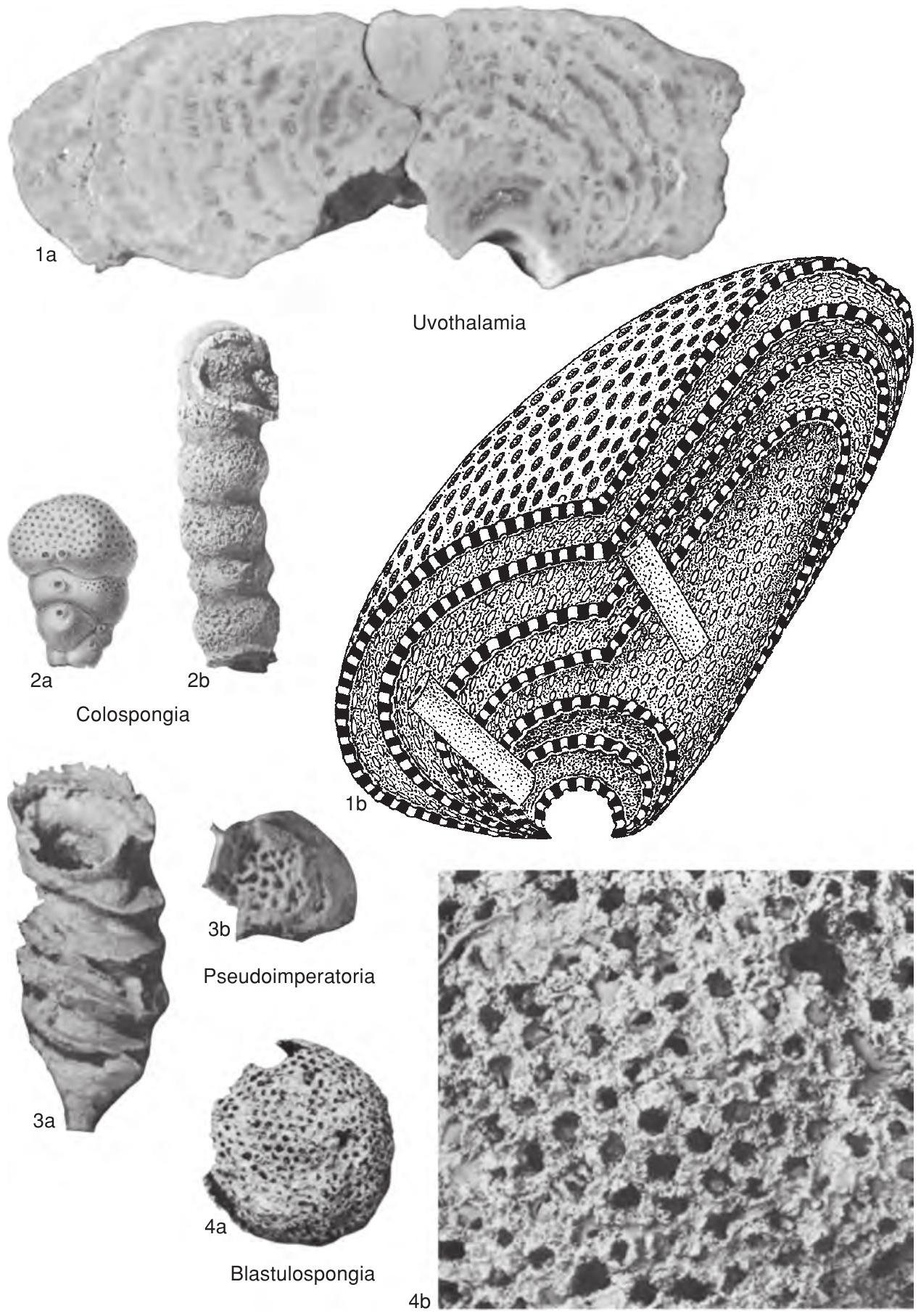Welcome to the Treatise on Invertebrate Paleontology!
Please enter a genera name to retrieve more information.

Colospongia
Classification
Phylum:
Porifera
Class:
Demospongea
Order:
Vaceletida
Superfamily:
Pileolitoidea
Family:
Colospongiidae
Formal Genus Name and Reference:
Colospongia LAUBE, 1865, p. 237
Type Species:
Manon dubium MÜNSTER, 1841, p. 28, OD
Images
(Click to enlarge in a new window)
Fig. 462, 2a. *C. dubia (MÜNSTER), St. Cassian beds, Middle Triassic, St. Cassian, Sud Tyrol, Austria; side view of typical sponge, X2 (Laube, 1865). —Fig. 462, 2b. C. cortexifera SENOWBARI-DARYAN & RIGBY, Biohermal complex, Lopingian, Djebel Tebaga, Tunisia; side view showing outer segmentation and coarse pores in chamber walls, X2 (Senowbari-Daryan & Rigby, 1988; courtesy of Facies).
Synonyms
Takreamina, Waagenium
Geographic Distribution
Europe, USA (Oregon), Canada (Yukon), Peru, Tunisia, Oman, China, India, Timor, Thailand, Russia, Armenia, Tajikistan, Kyrgyzstan
Age Range
Beginning Stage in Treatise Usage:
Carboniferous
Beginning International Stage:
Tournaisian
Fraction Up In Beginning Stage:
0
Beginning Date:
359.3
Ending Stage in Treatise Usage:
Triassic
Ending International Stage:
Rhaetian
Fraction Up In Ending Stage:
100
Ending Date:
201.36
Description
Spheroidal segments in linear series, successively increasing in size; no cloaca or central osculum; exopores small, subequal, circular, separated by more than their diameter and confined to upper two-thirds or so of each chamber, lower part of exowall secondarily imperforate, except for occasional, large, circular, lipped exopores, which may occur anywhere; interwall and interpores merely top of preceding chamber with its exopores; interior of chamber may contain large vesicles, continuous with secondary linings of chamber wall, convex inwardly and upwardly but no other skeletal tissue; wall microstructure microgranular aragonite as in living Vaceletia PICKETT (MASTANDREA & R USSO , 1995, p. 418); monaxon spicules imbedded in wall (SENOWBARI-DARYAN, 1989, p. 475). [Descriptions in the literature (e.g., Z ITTEL , 1878b, p. 27; STEINMANN, 1882, p. 172; HERAK, 1943, p. 129; SEILACHER , 1962, p. 738) were of specimens not congeneric with the holotype, which was redescribed by OTT (1967a, p. 50), who considered it congeneric with Girtycoelia KING, 1933. Because the latter genus has spherulitic, aragonite microstructure, the not very exact resemblance in gross morphology must be considered homeomorphic. The species described by SENOWBARI -DARYAN and S TANLEY (1988, p. 420), with cribribullae and subpolygonal exopores, is so different from the type species that it should probably be assigned to a new genus.]
References
Laube, G. C. 1865. Die Fauna der Schichten von St. Cassian. Ein beitrag zur Paläontologie der alpinen Trias, I Abtheilung. Spongitarien, Corallen, Echiniden und Crinoiden. Denkschriften der Kaiserlichen Akademie der Wissenschaften, Mathematischnaturwissenschaftliche Klasse 24:223-296, 10 pl.
Museum or Author Information
Classification
Phylum:
Porifera
Class:
Demospongea
Order:
Vaceletida
Superfamily:
Pileolitoidea
Family:
Colospongiidae
Formal Genus Name and Reference:
Colospongia LAUBE, 1865, p. 237
Type Species:
Manon dubium MÜNSTER, 1841, p. 28, OD
Images
(Click to enlarge in a new window)
Fig. 462, 2a. *C. dubia (MÜNSTER), St. Cassian beds, Middle Triassic, St. Cassian, Sud Tyrol, Austria; side view of typical sponge, X2 (Laube, 1865). —Fig. 462, 2b. C. cortexifera SENOWBARI-DARYAN & RIGBY, Biohermal complex, Lopingian, Djebel Tebaga, Tunisia; side view showing outer segmentation and coarse pores in chamber walls, X2 (Senowbari-Daryan & Rigby, 1988; courtesy of Facies).
Synonyms
Takreamina, Waagenium
Geographic Distribution
Europe, USA (Oregon), Canada (Yukon), Peru, Tunisia, Oman, China, India, Timor, Thailand, Russia, Armenia, Tajikistan, Kyrgyzstan
Age Range
Beginning Stage in Treatise Usage:
Carboniferous
Beginning International Stage:
Tournaisian
Fraction Up In Beginning Stage:
0
Beginning Date:
359.3
Ending Stage in Treatise Usage:
Triassic
Ending International Stage:
Rhaetian
Fraction Up In Ending Stage:
100
Ending Date:
201.36
Description
Spheroidal segments in linear series, successively increasing in size; no cloaca or central osculum; exopores small, subequal, circular, separated by more than their diameter and confined to upper two-thirds or so of each chamber, lower part of exowall secondarily imperforate, except for occasional, large, circular, lipped exopores, which may occur anywhere; interwall and interpores merely top of preceding chamber with its exopores; interior of chamber may contain large vesicles, continuous with secondary linings of chamber wall, convex inwardly and upwardly but no other skeletal tissue; wall microstructure microgranular aragonite as in living Vaceletia PICKETT (MASTANDREA & R USSO , 1995, p. 418); monaxon spicules imbedded in wall (SENOWBARI-DARYAN, 1989, p. 475). [Descriptions in the literature (e.g., Z ITTEL , 1878b, p. 27; STEINMANN, 1882, p. 172; HERAK, 1943, p. 129; SEILACHER , 1962, p. 738) were of specimens not congeneric with the holotype, which was redescribed by OTT (1967a, p. 50), who considered it congeneric with Girtycoelia KING, 1933. Because the latter genus has spherulitic, aragonite microstructure, the not very exact resemblance in gross morphology must be considered homeomorphic. The species described by SENOWBARI -DARYAN and S TANLEY (1988, p. 420), with cribribullae and subpolygonal exopores, is so different from the type species that it should probably be assigned to a new genus.]
References
Laube, G. C. 1865. Die Fauna der Schichten von St. Cassian. Ein beitrag zur Paläontologie der alpinen Trias, I Abtheilung. Spongitarien, Corallen, Echiniden und Crinoiden. Denkschriften der Kaiserlichen Akademie der Wissenschaften, Mathematischnaturwissenschaftliche Klasse 24:223-296, 10 pl.
